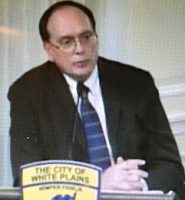Video Monitoring Coming to Some White Plains Intersections

Earlier this month, the White Plains Common Council approved the implementation of a demonstration program by American Traffic Solutions, Inc. to install and operate traffic control signal photo violation monitoring devices at some of the more dangerous intersections for pedestrians in the city.
The program is specific to traffic lights that have turned red, giving drivers a grace period of 0.4 seconds to come to a complete stop once the light has changed.
The program will also allow American Traffic Solutions to impose the state law fine of $50 for running a red light.
White Plains Commissioner of Parking and Traffic, Tom Soyk, explained during the Common Council meeting that the cameras would be installed on poles in the sidewalk area at different traffic lights around the city.
Citing a 40% increase in pedestrian accidents in 2017 over 2016, Soyk said the higher number was alarming because the amount of traffic increase over the same period of time had not increased as significantly. “Traffic has been steady,” he said.
In 2017 there had been 92 accidents involving pedestrians over 65 in 2016.
The top two intersections for pedestrian accidents are Maple Ave. and South Lexington Ave. and Martine Ave. and Mamaroneck Ave., Soyk explained. He added that there were several intersections with multiple incidents.
The goal of the program is to calm the flow of traffic and encourage drivers to be less aggressive, especially when making a right turn on a red light.
“Sometimes people come through and make a right turn on red without stopping,” explained Mayor Tom Roach. “The law requires that you stop and take a look around. This program is only looking at cars making that right turn.”
Both video and photos will be used to document what happens.
Mayor Roach noted that the Dept. of Public Safety was interested in the program because it will use high-definition cameras and the footage will be available. A lot of crimes have been solved in White Plains through the use of video,” Roach added.
Councilwoman Milagros Lecuona was the only member of the council to vote against the test program, which will be implemented for two and a half years before it comes up for review and renewal. Lecuona was concerned that using technology to deal with “bad behavior” was not the right approach and she did not want to put such a program into the hands of a private contractor. Lecuona would rather see other “calming programs” in place.
Mayor Roach said the program was another tool to be used by the city for safety. “Yield signs, slow down signs, stop signs, and traffic lights are traffic calming technologies that have been around a long time. People are not paying attention to them,” Roach said.
Before a summons is sent out the video will be reviewed by police to see if there is any issue.
About 18,000 traffic tickets are given out in White Plains over the course of a year.
Councilwoman Nadine Hunt-Robinson expressed her support for the program because it would encourage compliance with existing laws. ‘Walkability in some areas of White Plains is over 90%,” Hunt-Robinson said. “We want to keep it safe.”
Councilman Dennis Krolian expressed his astonishment at the number of pedestrian accidents. He would prefer to see live police pulling people over, rather than a tech program mailing out $50 summons, which he said seemed more like a slap on the wrist than an actual penalty. Krolian also suggested that maybe the city should consider giving out summons for jaywalking.
Soyk further explained that the demonstration program would not require any financial support from the city. If the number of $50 summons sent out did not cover the rental or operational costs of the cameras, American Traffic Solutions would not charge White Plains for the deficit.
